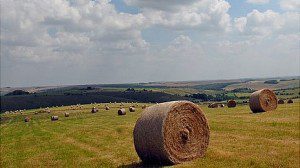
Images acquired by unmanned aircraft can reveal whether farmers are complying with EU rules on things such as hedges and ponds, or buffer strips around arable fields.
Imagine a perfect walk in the country a few years from now”tranquility, clean air, birdsong in the trees and hedgerows, growing crops swaying in the breeze. Suddenly a model plane swoops overhead. But nobody nearby is manipulating radio controls. This isn't a toy, but a drone on a photographic mission.
Meanwhile, hundreds of kilometers up in space, the same patch of land is being photographed by a satellite, which clearly pinpoints individual trees and animals.
What is there to spy on here? No secret military installations, just farmland. Europe’s farms cost taxpayers billions of euros in subsidies each year, and European Union (EU) agricultural inspectors are turning to technology to improve their patchy record on preventing fraud and waste.
Satellites have already been in use for several years, and drones are currently undergoing trials. Scanning a farm with a satellite costs about one third as much as sending an inspector on a field visit”£115 ($180; 150 euros) rather than £310 ($490; 400 euros), says the U.K.’s Rural Payments Agency (RPA), which is responsible for disbursing the subsidies in the United Kingdom and checking for irregularities.
According to the RPA, the agency follows up only on those claims where there is some doubt about accuracy, and then only at the specific fields for which the doubt exists. This saves time, lifts the burden on farmers and reduces cost to the taxpayer.
Satellites can rapidly cover a huge area in detail and quickly return to photograph it again if necessary. In 2010, about 70 percent of the total required controls on farm payments in the EU were done by satellites, which photographed more than 210,000 square kilometers (81,000 square miles) of land in all.
But they are not infallible. Austria does not use them, on the grounds that the shadows cast by mountainous terrain sometimes make satellite images inaccurate. And Scotland, unlike the rest of the United Kingdom, decided against satellites “because of the difficulty of getting enough clear weather for flyovers,” a Scottish government spokeswoman told the BBC.
Many things in the countryside are constantly changing, and when the satellite passes over, “the animals may be in a field or in a barn”you can’t count the numbers very well,” says Roland Randall, an English farmer and environmental researcher in Cambridgeshire.
“When planners looked at the aerial photo records of our farm they thought we had an additional building without permission, but it was actually a haystack,” he told the BBC.
The satellite checks are done partly to produce accurate maps of farms, showing clearly the areas eligible for subsidies. But farmers these days have to keep their land in “good agricultural and environmental condition” to qualify for subsidies, so images also reveal whether the farmer is complying with the rules on hedges and ponds, say, or buffer strips around arable fields.
There have been few prosecutions in the United Kingdom based on satellite evidence, according Ray Purdy, a senior law researcher at University College London (UCL) specialising in satellite monitoring. One case in the United Kingdom was dropped in 2001 because a farmer proved he had planted a linseed crop, even though the satellite image appeared to show bare earth. The sparse young plants had failed to show up against the bright reflection off chalk downland.
This could be the kind of situation where a drone or unmanned aircraft system (UAS) would be useful. Drones are best known for their role as remote-control killers in Afghanistan and Pakistan’s tribal areas, but supporters see a role for smaller and much simpler drones in agricultural monitoring. They can get up close and take sharp photographs”and unlike satellites, which always look directly down, drones can get an angled view of their subject.
They are currently being tried out in vineyards in the south of France to check that “grubbing up” of vines is done legally and ecologically. Wine growers get as much as 10,000 euros ($13,000; £8,300) per hectare in subsidies for digging up uncompetitive vines”a scheme to prevent new EU “wine lakes” caused by overproduction.
“There has to be 100 percent control, as it’s a huge amount of money,” says Philippe Loudjani, an agronomist at the Joint Research Centre, the European Commission’s main satellite monitoring hub in Ispra, northern Italy.
“The French are testing to see if the drones need to go up to 10-centimeter resolution”to see what accuracy is required.”
Drones are also being tested in Italy, and are already in use on a small scale in Spain’s Catalonia region, where authorities say their 25- and 12.5-centimeter resolution photos are ideal for inspecting the small landholdings with mixed crops that are typical of the Mediterranean. The EU is hurrying to develop a strategy for unmanned aircraft systems, which would see the existing tough restrictions on the use of civilian drones in Europe relaxed.
Source: BBC

